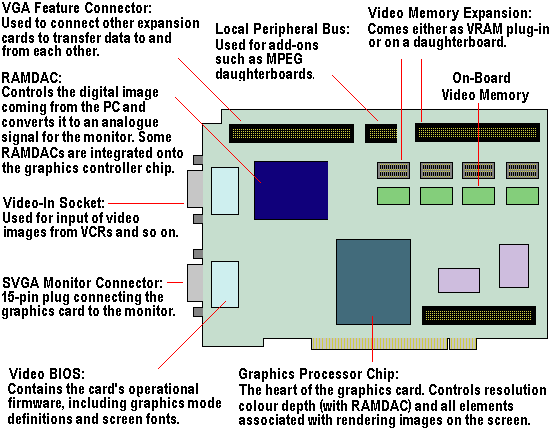The modern PC graphics card consists of four main components:
- the graphics processor
- the video memory
- the random access memory digital-to-analogue converter (RAMDAC)
- the driver software

The early VGA systems were slow. The CPU had a heavy workload processing the graphics data, and the quantity of data transferred across the bus to the graphics card placed excessive burdens on the system. The problems were exacerbated by the fact that ordinary DRAM graphics memory couldn’t be written to and read from simultaneously, meaning that the RAMDAC would have to wait to read the data while the CPU wrote, and vice versa.
Many times per second, the RAMDAC reads the contents of the video memory, converts it into an analogue RGB signal and sends it over the video cable to the monitor. It does this by using a look-up table to convert the digital signal to a voltage level for each colour. There is one Digital-to-Analogue Converter (DAC) for each of the three primary colours the CRT uses to create a complete spectrum of colours. The intended result is the right mix needed to create the colour of a single pixel. The rate at which the RAMDAC can convert the information, and the design of the graphics processor itself, dictates the range of refresh rates that the graphics card can support. The RAMDAC also dictates the number of colours available in a given resolution, depending on its internal architecture.
The problem was solved by the introduction of dedicated graphics processing chips on modern graphics cards. Instead of sending a raw screen image across to the frame buffer, the CPU sends a smaller set of drawing instructions, which are interpreted by the graphics card’s proprietary driver and executed by the card’s on-board processor.
Operations including bitmap transfers and painting, window resizing and repositioning, line drawing, font scaling and polygon drawing can be handled by the card’s graphics processor, which is designed to handle these tasks in hardware at far greater speeds than the software running on the system’s CPU. The graphics processor then writes the frame data to the frame buffer. As there’s less data to transfer, there’s less congestion on the system bus, and the PC’s CPU workload is greatly reduced.
- How Do Computers Make Pictures?
- Graphic Card Resolution
- Graphic Card Colour Depth
- Graphic Card Components
- Graphic Card Memory
- Graphic Card Driver Software
- 3d Accelerated Graphic Cards
- Graphic Card Geometry
- 3D Rendering
- FSAA Graphic Card Technology
- Digital Graphic Cards
- DVI Graphic Cards
- HDCP Technology
- Graphic Card HDMI Ports
- Graphic Card Display Port
- Unified Display Special Interest Group
- DirectX
- OpenGL technology
- Direct3D
- Talisman
- Fahrenheit Graphic Cards
- SLI Technology
- CrossFire Graphic Cards